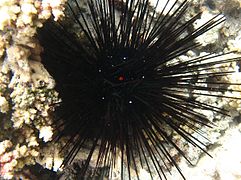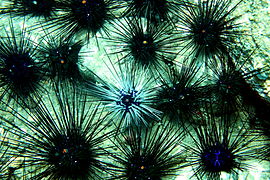Diadema setosum
| Diadema setosum | |
|---|---|

| |
| Diadema setosum in Oman. | |
| Scientific classification | |
| Domain: | Eukaryota |
| Kingdom: | Animalia |
| Phylum: | Echinodermata |
| Class: | Echinoidea |
| Order: | Diadematoida |
| Family: | Diadematidae |
| Genus: | Diadema |
| Species: | D. setosum
|
| Binomial name | |
| Diadema setosum Leske, 1778[1] | |
| Synonyms[1] | |
| |
Diadema setosum is a species of long-spined sea urchin belonging to the family Diadematidae. It is a typical sea urchin, with extremely long, hollow spines that are mildly venomous. D. setosum differs from other Diadema with five, characteristic white dots that can be found on its body. The species can be found throughout the Indo-Pacific region, from Australia and Africa to Japan and the Red Sea. Despite being capable of causing painful stings when stepped upon, the urchin is only slightly venomous and does not pose a serious threat to humans.
Description
As a member of the class
In addition, a clear distinguishing characteristic of the species is the presence of a bright, orange ring around the urchin's
-
General look
-
Detail of the anal papilla.
-
Close-up on the classical characteristics : orange ring, five white spots, blue iridophores.
-
Specimen with white spines.
Distribution and habitat

Diadema setosum is a widely distributed species of sea urchin. Its
The species has been introduced into other localities not within its natural range. In 2006, two living specimens of Diadema setosum were found in waters off the
Diadema setosum is commonly associated with
In Hong Kong, Diadema setosum is omnipresent in rocky reefs, with a population density of up to one individual per 3.4m2. The unusually large number of these urchins is theorised to be partly natural, and partly due to overfishing of its primary predator in the region, the blackspot tuskfish (Cheorodon schoenleinii).[7]
Biology
The species has been known to spawn both seasonally and year-round depending on the location of the spawning population. It has been suggested that Diadema setosum populations are temperature-dependent in their spawning seasonalities. Temperatures higher than 25 °C (77 °F) have been cited as a possible spawning cue.
Evolutionarily, Diadema setosum is considered one of the oldest of the known
Like other venomous sea urchins, the venom of Diadema setosum is only mild and not at all fatal to humans. The toxin mostly causes swelling and pain, and gradually diffuses over several hours. More danger is presented by the delivery system – the urchin's spines which are extremely brittle and needle-like. They easily break off within flesh and are quite a challenge to extract.[13]
In terms of behavior, D. setosum has been observed to be able to avoid danger by rapidly inverting its body and "running" on the tips of its longest spines. This behavior is triggered by sudden impacts and the snapping of one or more of its spines. During the process, upon encountering small obstacles, D. setosum will take on a rolling motion much like the robot TARS from Interstellar. It has been observed to move 30 inches in just 7 seconds using this method of locomotion.
It is also worth noting that this particular variety has some of the very best vision observed among sea urchins and will regularly redirect spines toward passing fish as a defense mechanism. Although unclear, this vision seems to be achieved by the sensing of light that enters each spine and it transmitted down the spines shaft and sensed at the base, although further scientific research is required.
Gallery
-
From Zanzibar
-
Fromla Réunion
-
A specimen encountered in Kenya. The 5-fold symmetry is obvious.
-
D. setosum along with Diadema savignyi : test shape, spines length and orange ring help telling them apart.
-
A classical specimen with long, black spines. The characteristic orange ring is visible in the photo.
Bibliography
- Alsaffar, Adel H.; Khalid P. Lone (2000). "Reproductive cycles of Diadema setosum and Echinometra mathaei (Echinoidea: Echinodermata) from Kuwait (Northern Arabian Gulf)". Bulletin of Marine Science. 67 (2): 845–856.
References
- ^ a b Kroh, Andreas (2013). Kroh A, Mooi R (eds.). "Diadema setosum (Leske, 1778)". World Echinoidea Database. World Register of Marine Species. Retrieved 2013-11-22.
- ^ .
- ^ Clark, HL (1925). A catalogue of the recent sea-urchins (Echinoidea) in the collection of the British Museum (Natural History). London: British Museum. p. 250.
- ^ a b Alsaffar, Adel H.; Khalid P. Lone (2000). "Reproductive cycles of Diadema setosum and Echinometra mathaei (Echinoidea: Echinodermata) from Kuwait (Northern Arabian Gulf)". Bulletin of Marine Science. 67 (2): 845–856.
- ^ a b c Coppard, Simon Edward; Andrew C. Campbell (2006). "Taxonomic significance of test morphology in the echinoid genera Diadema Gray, 1825 and Echinothrix Peters, 1853 (Echinodermata)" (PDF). Zoosystema. 28 (1): 93–112. Archived from the original (PDF) on 2006-11-27. Retrieved 2009-01-12.
- .
- ^ "Diadema sea urchins and the Black-spot tuskfish".
- ^ Pearse, John S. (1974). "Reproductive patterns of tropical reef animals: three species of sea urchins". Proceedings of the 2nd International Coral Reef Symposium. 1. Brisbane, Australia: ICRS: 235–240. Retrieved 2009-01-12.
- ^ Tuason, A. Y.; Ed D. Gomez (1979). "The reproductive biology of Tripneustes gratilla Linnaeus (Echinodermata: Echinoidea), with some notes on Diadema setosum". Proceedings of the International Symposium on Marine Biogeographic Evolution. 2. Auckland, New Zealand: 707–716.
- .
- ^ "Reproduction of the long-spined sea urchin Diadema setosum in the Gulf of Aqaba". Retrieved 2 February 2023.
- ]
- ISBN 0-86840-279-6.
External links
- Photos of Diadema setosum on Sealife Collection









